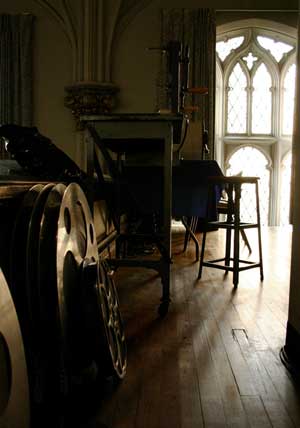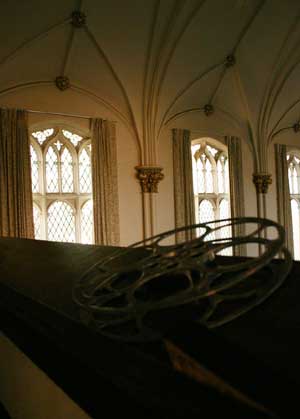

Preview Issue 01.01.06
Backyard | by Andrea Avery
Hidden Pulleys on Balcony Four | by Aaron Belz
The Bars of Our Fathers | by Thom Fletcher
Deep in the heart of Chesterfield: A city rat considers the suburbs | by Chris King
Schoolhouse
Coffeehouse | by Michaela McGinn
This Way Chuck Berry | by Thomas R. Raber
Sonnet: PSA | by Tony Robinson
Stardust in a Phrygian Key | by Stefene Russell
Sophomores | by Julia Smillie
The Ghosts of Winifred Moore | by Mike Steinberg
Four Days Behind the Iron Curtain, or, I'm With the Band | by Mary Kaye Tonnies
Late Night Radio | by Brett Underwood

The Ghosts of Winifred Moore | by Mike Steinberg




Winnifred Moore
Photos: KATE CLANCY
I can’t concentrate. I have a lot of work this week. Mid-term grades to conjure, a quarterly calendar of films to program for the Webster University Film Series, a dozen or so vinyl LPs on Ebay I’m coveting, and this lingering question I’ve just been asked: “Is the Moore Auditorium haunted”? (Actually I’m asked this question all the time, or at least often enough that I might remark on it, might even give myself to more than idle speculation of whether or not it is). Listen: I don’t really go for the occult, don’t hold much faith in any of our abilities to table-rap the future or glean some useful inkling about tomorrow from gilded or otherwise tools of divination. But take it from me pal, as skeptical as I’m apt to be, this joint is crawling with ghosts.
Webster Hall, where the Winifred Moore Auditorium is housed, was built in 1915, and before it was the home to the University’s alternative film series, it was a chapel. There’s still quite a bit of evidence of its holier days: the twenty-foot screen and the huge curtains which line the side walls hide tall stained-glass windows; there are photos of past statuary; the great barrel-vaulted ceiling (thankfully no one installed a dropped ceiling in 90-plus years to cut down on heating bills) still towers above the room, reaching upwards toward where you might expect to find heaven. The projection booth on the balcony was constructed on what was once the choir loft, and you can still see some of the old pews in the lobby area, and lining the halls of all four floors of the building.
There are other remnants as well, less visible to the casual visitor because they are tucked away, or painted over. But if one ventures backstage, for instance, and climbs the Hitchcockian-steep spiral stairs to what was once the belfry you see, in the right patch of daylight, the most dramatic stained glass feature, a large round work like a giant lotus flower, nearly thirty-feet from top to bottom. It remains although its congregation has gone, a ghost of sorts, haunting the empty space.
And beyond what’s left of consecrated architecture, there must also be something else that remains. So much in the realm of the spirit happened here, there must be some lasting remnants of the certain blessings made or prayers offered. There must be the faint note from the long gone pipe organ or the impassioned choir – so faint, mind you, you must strain completely to hear, and even then it’s only a distance breath. Maybe there is something left from the pomp and circumstance – the melted wax, the incense, the faint dust of smudged ash, maybe the dissipating smoke from a candle. There must be something, or even the essence of something, some ritual or ceremony or something sent up from those in need, or those in praise, or those in only dumbfounded awe at the beauty of some soft Sunday morning 75 years ago when Webster Groves was younger and even lovelier. There must be something for sure, and in a way, ghosts as well.
The Webster Chapel became a movie theater in 1974. It was named for, as best as I can tell, an Opera singing benefactor. Before a formal film series was organized in 1978, there was the Webster Film Society, a dedicated group of (mostly) hippies who got together on weekend nights and organized screenings of foreign and classic films. In an age before the eventual choices of “Beta or VHS?” they gathered in the prior chapel, and took in the latest Antonioni or Godard. They also watched through (one might imagine) ragged curls and bloodshot eyes, Vigo’s newly rediscovered L’Atalante, or Chaplin’s Modern Times, and mourned what must have seemed like the loss of a grand art form, what with punks like George Lucas and Brian De Palma slopping up the screen at all the other theaters near them. In ‘78, the series found its footing toward the eventual venue it would become. Now, 26 years later, crowds gather weekly to take in the latest Antonioni or the latest Godard, to mourn the lost art form as punks like George Lucas and Brian De Palma….They cozy themselves down in what are without a doubt the most comfortable seats in town, screw on a gaze to the screen, give up whatever passes for reality (outside the theater) for a couple hours at a stretch, and become for the time being more or less otherworldly themselves.
I work in this theater every day – my office is directly behind the projection booth – and I make my way through the halls of this building, the whole of which is also supposedly full of ghosts – on the fourth floor, at least: Sister Mary So-&-So roaming the corridors or reading a Bible to the open window, or passing through a classroom wall, leaving behind only a glowing layer of ectoplasm! (Insert spine-chilling Theremin sounds here). And although there is no literal Phantom haunting the theater, no Lon Chaney as Erik, striking up the first few notes of Bach’s Toccata and Fugue in D Minor, or rowing through subterranean canals, no, say, Howard Hughes to our Pantages, no Victor Kilian to our Graumann’s Chinese, there is in fact a constant presence I don’t quite know how to explain.
Perhaps it is as French film theorist André Bazin imagined, that cinema is something holy and somehow ethereal. In his essay “The Evolution of the Language of Cinema” (1950), Bazin described an image in film as “freed from the conditions of time and space that govern it.” It is no longer a real object, only the impression of an object. Bazin saw the cinematic experience as transformative, able to alter something real (an actor, an object, etc.) into something reel (the apparition on the screen). He called it its “tracing.” But we might just as well call them “ghosts” - these imaginary figures moving in mind-boggling intermittent motion – something roughly metaphysical, this almost literal smoke & mirrors of the persistence of our vision.
Often, as we watch them move about the screen, as they lull us into a more than willing suspension of disbelief, as we lose ourselves, voluntarily giving up whoever we actually are in favor of the darker joys of “watching the movie,” we are experiencing something transformative as well. As they flit about, all silvery and smooth, we feel almost stunned in their presence. And certainly, this darkness is where we expect to see them, whomever they resemble: Abbot & Costello or Toshirô Mifune, maybe even Topper himself, pouring a vaporous martini. And when they do something that we cannot forget, like dive at the last moment away from the roaring crop-duster, or flow down the opulent staircase, demanding their close-up, they startle us in that way we know only ghosts can. Other times, we are transformed into something ghostly ourselves. When, for example, Gene Kelly takes Cyd Charisse, her great twisting silk streamer and all, so completely in his arm, in the midst of this great and obvious apparition, this overgrown parlor trick of optical illusions, this fancy-dancing of light on a smooth beaded screen – it becomes finally, vaguely, what we could almost call real, and yes, it is only a movie (it’s only a movie… it’s only a movie) but it becomes for a moment materialized as the truest thing to ghosts.
Although we usually exhibit films at the series on the weekends, films are projected daily in the theater. Most mornings the projection booth rumbles awake, the huge exhaust fan whirls, ready to cool the motors of the 35mm Simplex projectors as Dick Bauer, the extremely precise projectionist and house manager of the Moore Auditorium does his routine checks of film prints that have arrived for upcoming screenings. At work on something in the office, we hear the cranking, the ticking and the rattle of the projector. Soon the reels are loaded. The film is threaded, and the print works its way through the guides and gears, finding a smooth path through the projector like a thin snake. As each frame hits the brilliant light of the film gate, the image is projected into the dark room, and on to the great screen. Suddenly they are riding in Monument Valley, or driving an Edsel or holding one another tightly and the beam of light that carries them to the screen is also alive in the stunned morning air.
BIO
Mike Steinberg is the Program Director for the Webster Film Series at Webster University. He has worked on numerous film festivals and his own films have earned placement in national film festivals, including Silverdocs, the Big Sky Documentary Film Festival, Bare Bone Independent Film Festival, Hardacre, and the Texas Film Festival. Additionally, his work has been screened at Midtown Arts Center, Chicago’s Navy Pier, Washington University, and The Slumdance Film Festival in Park City, Utah. He has taught and lectured at Webster University, the University of Montana, St. Louis Community College, the Center of Contemporary Arts and at the College of Languages in Lodz, Poland.
Katie Clancy is a bartender and freelance photographer. She likes greasyspoons, renegades, b&w photobooths, and people that sing and dance (even if they aren't very good). She also likes the smell of cleaning supplies and nag champa, but she isn't sure why.